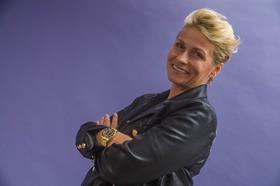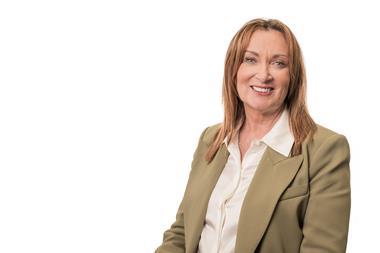In recognition of International Women’s Day, Insurance Times takes a closer look at diversity and inclusion within senior broking leadership, reviewing the current landscape and factors impacting progression
Back in October 2021, I attended my first Insurance Times Broker CEO Forum event since my tenure as editor. Exclusively for broking senior leadership, the invite-only, two-day retreat is designed so that broker chief executives and managing directors can network, debate and share best practice with their peers, as well as rub shoulders with potential insurer and insurance ecosystem partners.
Usually at conferences or networking gatherings, the queue for the ladies bathroom consistently snakes along adjacent corridors or through wearily propped open doors thanks to the constant ebb and flow of visitors.
When event attendees are senior broking leadership, however, my only competition for cubicles at the Broker CEO Forum’s 2021 venue, Pennyhill Park Hotel and Spa, was Sara Fardon, managing director of Willis Towers Watson Networks.

Although maybe a crude example, the incident brought home for me how few and far between female broker chief executives are and their absence from our October event was striking – this is definitely something we are seeking to rectify for our 2022 get together.
As we approach International Women’s Day on Tuesday 8 March 2022, I thought it was time Insurance Times conducted a temperature check of gender-related diversity and inclusion (D&I), specifically looking at the senior broking leadership demographic.
Being ‘one of the few women in the room’
Jackie Hyde, owner and managing director of Stanmore Insurance Brokers, has noted similar experiences of being the only woman of seniority at meetings.
She told me: “It is really great to see females taking up senior positions within insurance companies, however the broking sector is still predominantly male dominated at ownership and director [level].
“On a quarterly basis, I meet with fellow broker owners and directors - I am still one of the few women in the room.”
Hyde’s route to management was also tumultuous to say the least. Upon returning from maternity leave in 1988 to her job at an insurer, she “saw a difference in how I was treated”, while her career ambitions were “regularly dismissed”.
It also took her three attempts to initially secure a job at Stanmore Insurance Brokers – she eventually started her tenure there at the age of 23, despite the company initially seeking “someone with more experience and male”.
Notwithstanding these initial roadblocks and the fact that “working mums were quite rare” at the time, Hyde knuckled down and was able to purchase shares in the broker when she turned 39 – she is now the sole owner of the business.
“Working for the business has been challenging as initially the majority of business owners were male and unsure about a female insurance advisor,” she said.
“There are, unfortunately, still issues between males and females in the workplace with inappropriate comments. You just have to be strong to challenge these when they arise.”
In Hyde’s opinion, the lack of D&I in broking leadership can be attributed to the industry’s “perception issue” of being “a male dominated sector”, as well as women’s own lack of “self-belief and confidence”.
She explained: “If [women] are in an environment that doesn’t encourage them to develop, then they can often be left behind in their careers.
“Men are generally the opposite and will put themselves forward, even if their ability is questionable. Due to the imbalance [of] male and females in [insurance workplaces], women find it difficult to promote themselves.

“In respect of ownership of businesses, there are huge areas of risk and women seem to struggle to be prepared to take risks that could put their personal wealth at jeopardy. Again, I feel this is a lack of self-belief.”
The story behind gender pay gaps
Hyde’s observations about minimal women occupying senior broking roles resonate when we take a closer look at firms’ gender pay gap reporting – a mandatory annual requirement from the UK government for companies that employ more than 250 staff.
In February 2022, for example, broker Marsh published its latest statistics based on snapshot data taken on 5 April 2021.
For Marsh Services Limited, which includes the UK businesses of Marsh Limited, Marsh McLennan and Guy Carpenter, employees within its highest pay quartile – so most likely to be c-suite and senior leadership – consist of 76% men compared to 24% women.
Its second highest pay quartile contains 61% male staff versus 39% female employees.
Marsh Services’ mean gender pay gap for 2021 shows that female employees are paid 33.5% less than their male counterparts.
A matching trend can be seen at Jelf Insurance Brokers, with Marsh reporting that employees within the highest pay quartile are 67% male and 33% female.
In the report’s foreword, Chris Lay, chief executive of Marsh UK and Ireland, and Paul Moody, UK chief executive of Guy Carpenter, noted: “We know our reported gender pay gap is primarily related to our workforce profile and the higher proportion of men than women in senior roles across our whole organisation.”
This means the firm wants to “advance more female colleagues into senior roles and, therefore, into higher paid quartiles”.
A similar story can be seen within Aon UK’s latest gender pay gap report, based on snapshot data from April 2020. Employees within its highest pay quartile consist of 76.7% men and 23.3% of women. Its lowest pay quartile, however, includes 59% women and 41% men.
The broker’s hourly mean gender pay gap shows that male staff are paid 35.6% more than female employees.
Aon UK has made some progress, however. Its report said: “We have doubled the number of women in senior leadership roles between 2015 and 2020, from 9% to 18% and we know that we need to do more.”
Let’s take one more example – Aston Lark’s most recent gender pay gap report at time of writing, based on snapshot data from 5 April 2020. Here, male employees are paid 31% more than female staff – a 2.3% increase compared to the firm’s 2019 figures.
Although noting that a key driver of its gender pay gap numbers is the volume of female staff employed in part-time roles compared to male part-time staff, the report “also clearly illustrates concerns with representation [of] women in senior positions, which by their nature are higher paying”.
The report continued: “Since the snapshot date, we have made some progress with expanding women in leadership roles, but we clearly have some work to do in this area as senior leadership positions are currently predominantly male.”

In its highest pay quartile, 67% of staff are male, compared to 33% female. Aston Lark’s lowest pay quartile includes 32% of male staff versus 68% of female employees.
Purposefully pushing D&I
Although the broking sector is therefore not inundated with senior female leaders, based on these gender pay gap report findings, “the UKGI broking sector has made great strides in this area”, according to Carol Hughes, senior associate of client relationships at Willis Towers Watson (WTW) Networks.
For example, she noted that her colleague Fardon has held her leadership position for the past 11 years.
“I’ve seen progress in both gender and overall diversity across our own membership - and this is across all levels from managing director downwards. This is true in the more established brokers, as well as the new members we are attracting,” she continued.
“There’s clearly been a shift in larger broking firms seeing the importance of having a more diverse workforce.”
Despite acknowledging that achieving “diversity is hard” and “a tough gig”, Julie Page, Aon UK’s chief executive, agreed that “the dial is moving” around D&I – but only where firms “are being quite purposeful”.
For example, she believes the “intent is changing” around talent attraction.
Although Page noted that brokers do not set out “to allow unconscious bias to exist in their organisations”, the war for talent has left little time to revamp recruiting systems and processes, meaning that firms have been focused on the “speed” of hiring and “going for what they know” because “everything is pressured and it’s hard to change systems”.
Now, however, Page thinks an “acceleration” of change is afoot.
She explained: “If you can put a label on your door that says ‘we’re the best place for diverse talent’, you’ve [then] got access to a pool that the worst place for diverse talent doesn’t have access to.
“I just think the whole talent agenda has shifted so much that we’ll see change coming through – especially [with] people like me and a number of my peers around the industry being very purposeful about it.”
One such firm “focusing a lot of our efforts” on D&I is broker A-Plan, which is led by chief executive Kelly Ogley.
Although conceding that the business has still “got some distance to go” in terms of D&I, Ogley added that “on each of the A-Plan Group businesses, we have strong female representation”, with “three out of four of A-Plan’s board members” being female.
Alongside Ogley, for example, is Endsleigh Insurance chief executive Alison Meckiffe as well as Julie Adams-Moore, chief executive of KGM Underwriting Services.
“It’s a great start that there is so much more heightened awareness of [D&I] issues,” Ogley continued.
“We are heading in the right direction and we are much further forward than we were when I first started out in the industry, but clearly there’s so much more we have to achieve and that’s something we have to do together.”
Defining inclusivity
Recent key industry themes are also having an impact on firms’ D&I agendas.
Let’s take broker consolidation, for example, which has been happening at pace for a good couple of years now.

Hyde believes consolidation can have a negative effect for female staff who are working parents, meaning some may opt to leave the insurance sector.
She explained: “Many women in brokers have joined the organisation because it is local to their homes and has benefits in childcare. They are home sooner rather than travelling long distances.
“Consolidation is likely to remove this facility as local offices are being closed and moved to larger premises. It is highly likely that this will mean women will move to other sectors as the locality is important.”
Hughes, meanwhile, felt the impact of consolidation could be a “double-edged sword” when it comes to D&I.
“If the acquired broker had never focused on D&I and is being left to [its] own devices, inevitably [the broker] may not mirror the ethos that the wider group company has,” she said.
“Alternatively, it could be a positive where brokers [that have] got a good D&I programme will be bringing positive benefits to everyone in that broker group.”
Plus, “larger firms may have more resources and more formalised D&I programmes” as well as a “dedicated D&I resource within their business”, Hughes continued.
This is something Ogley has experience of following A-Plan’s acquisition by Howden Group in early 2021. She said the broker is looking to align its D&I strategy with its new parent company.
Howden’s “D&I approach is led by a D&I committee, chaired by members of the board and the group executive committee”, she continued.
Howden Group also has an employee resource group, called Respect, which A-Plan can tap into. This is “an employee-led group that shares, educates and informs on all matters to do with diversity, inclusion and culture”.
Another important influencing factor on D&I has been the hybrid working models arising from the Covid-19 pandemic, where employers are empowering staff to mix home and office-based working.
Hughes thinks hybrid working approaches have “enabled flexible working to be embraced, which has been very helpful in enabling work-life balance to become more attractive, particularly to working mothers.
“I believe that is helping bring a career in insurance to the forefront of opportunity for women.”
Although hybrid working enables employers to tap into talent pools spread across the UK, as attending an office location is now not paramount for many positions, Page believes it has also created “a new definition of inclusivity”.
She said: “We’ve talked about inclusivity from all the different usual dimensions – ethnicity, gender, lesbian, gay, bisexual, transgender, queer (LGBTQ+). What we’re dealing with now is work persona – it’s a new form of inclusivity.”
How can brokers boost D&I at their firms?
To bolster female representation within senior broking leadership, many D&I initiatives are starting by encouraging women to apply for entry level roles and join the sector. Stanmore Insurance Brokers, for example, works with its local university and career fairs to this end.
The broker’s owner and managing director Jackie Hyde is also involved with the Women Leaders Association, the She Inspires Awards and female focused social enterprise Girls Out Loud.

Meanwhile, broker Howden offers a Get Into Insurance programme with The Price’s Trust and the London and International Insurance Brokers Association. The two-week initiative can lead to a 12-week paid internship at the firm.
A-Plan chief executive Kelly Ogley added that the broker is also “launching a Women in Leadership project, to encourage and support more females to put themselves forward for leadership roles”. This is due to be implemented in September 2022.
Reviewing recruitment and promotion practices as well as providing mentoring and coaching are also important, alongside engaging with external events, such as the annual Dive In festival and initiatives run by insurers, such as Aviva’s Future Leadership Programme and Touch of Purple event.
Allyship can also support minority groups, “but it’s only impactful if people are active”, added Carol Hughes, senior associate of client relationships at Willis Towers Watson Networks.
Hosted by comedian and actor Tom Allen, 34 Gold, 23 Silver and 22 Bronze awards were handed out across an amazing 34 categories recognising brilliance and innovation right across the breadth of UK general insurance.




















































No comments yet